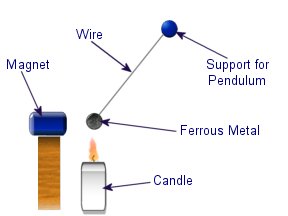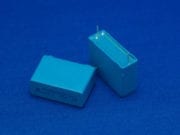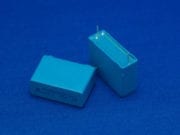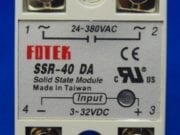Curie Effect Demonstration
 The curie effect usually refers to a magnetic phenomenon discovered by Pierre Curie. He discovered that ferromagnetic substances exhibited a critical temperature transition, above which the substances lost their ferromagnetic behaviour. This is now known as the Curie point.
The curie effect usually refers to a magnetic phenomenon discovered by Pierre Curie. He discovered that ferromagnetic substances exhibited a critical temperature transition, above which the substances lost their ferromagnetic behaviour. This is now known as the Curie point.
A simple experiment, often named ‘the curie effect heat engine’ is a great way do practically demonstrate this important scientific principle.
A ferrous metal object such as a screw is suspended by a length of stiff wire so that it can swing freely from left to right.
To one side of the pendulums swing, a magnet is fixed into a position where it attracts the mass on the pendulum, and holds it up preventing it from swinging. The magnet must be far enough away so that it holds the mass up, but without actually touching it.
When a heat source such as a candle is place under the ferrous mass, the temperature of the material will increase until it reaches the curie point. When this occurs the thermal noise in the material prevents it from being held by the magnet and it will swing away. This will quickly allow the mass to cool and on its return swing (or before) the magnet will pull the mass back over the heat source, causing the whole process to start again.






Just use a steel nut or bolt.
where can u get iron to perform this experiment with???
The curie point is used by Sony in their miniDisc recorders. Wikipedia has a fairly good article on it. It is one of the few applications still in production which uses the curie temperature as the basis of its functionality.
What uses does this effect have? Where in nature or in appliances can we find it?
PIERRE CURIE IS MY HERO! 🙂
Coathanger wire or similar will be fine. You can also bend some into a frame to make a support for the pendulum.
What kind of wire do you recommend using for this demonstration? Also, what do you recommend mounting the pendulum on?
The ferrous mass is held in place by the magnetic field of the nearby magnet.
I’ve no idea what you you mean by “how the effect of the sound will be?”.
When the metal heats up it reaches it currie point at which the magnet can’t hold it in place so it falls.
As it says on the comment form “We will not reply to you by email”
what is mean by ” it attracts the mass on the pendulum”. when Ferrous metal is heated how the effect of the sound will be?. i request u to replay to my id..
my id is dhinesh1989@gmail.com